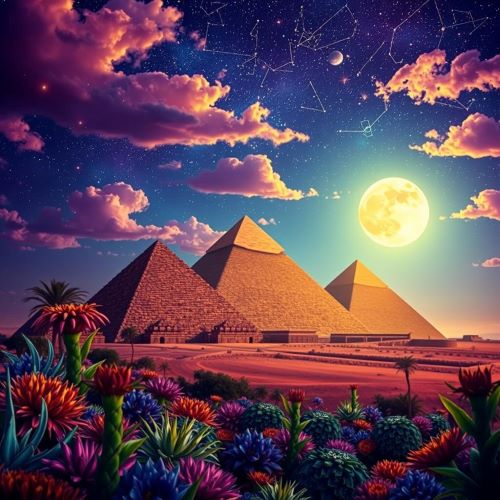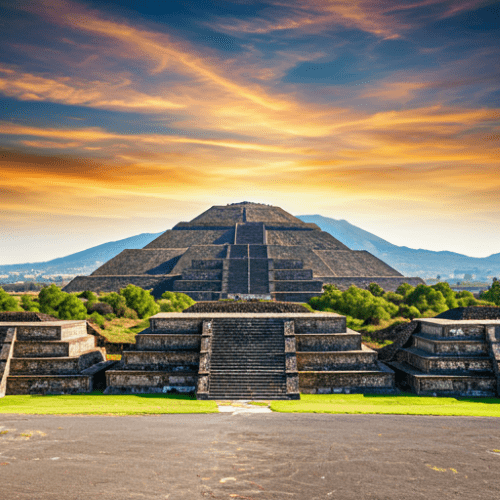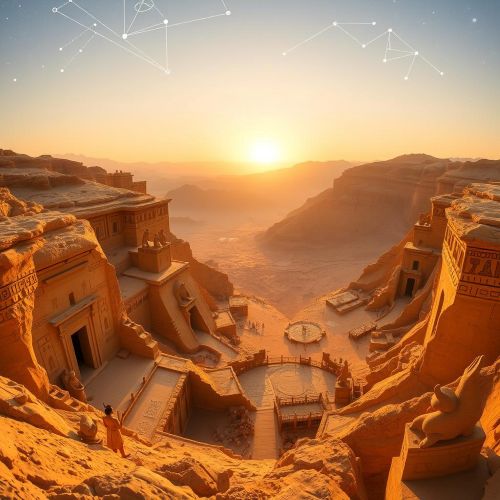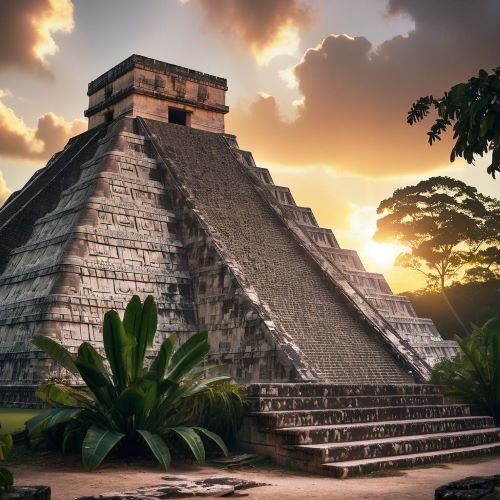Great Pyramid of Cholula : Inside Mexico’s Massive Ancient Pyramid
At a glance
| Description | |
|---|---|
| Mythology | Aztec Mythology |
| Country | Mexico |
| Closest airport | Hermanos Serdán International Airport, PBC |
| Type | Constructed |
| Accessibility | 09/10 |
Grand Pyramid of Cholula
Introduction
The Great Pyramid of Cholula, rising from the heart of Cholula in Puebla, Mexico, stands as the largest pyramid on Earth by volume and one of the most layered historical monuments in the world. Known in Nahuatl as Tlachihualtepetl, meaning “man-made mountain,” this immense structure merges centuries of architectural innovation with the spiritual worldview of ancient Mesoamerican cultures. Its appearance—now resembling a vast grassy hill crowned by the Church of Our Lady of Remedies—conceals a monumental complex built over a thousand years. For modern travelers, the Great Pyramid offers a rare opportunity to explore deep archaeological tunnels, panoramic landscapes, and living traditions that connect the present with the mythic past.
Connection with Mythology
The Great Pyramid of Cholula is inseparable from the mythical imagination of the Aztecs and earlier civilizations. According to Aztec tradition, the giant Xelhua, one of the legendary Quinametzin giants, built the pyramid after surviving a great flood. Driven by ambition, he attempted to raise a sacred mountain that reached toward the heavens. Angered by this defiance, the gods struck the structure with fire from the sky, halting the giant’s work. This tale reflects the ancient belief that monumental constructions were attempts to bridge earth and the divine, while divine intervention preserved cosmic balance.
The pyramid was also deeply associated with Quetzalcoatl, the feathered serpent deity revered as a creator, teacher, and bringer of civilization. Offerings discovered at the site—including seashells and ceremonial objects—suggest that pilgrims from across Mesoamerica once traveled to Cholula to honor Quetzalcoatl. Before the arrival of the Spanish, the pyramid was sacred to rain deities as well, especially Nine Rains (Chiucnāuhquiyahuitl), highlighting its role in agricultural rites and water-related ceremonies. Its original Nahuatl name Cholollan, meaning “place of refuge,” further reveals its spiritual importance as a sanctuary for those seeking divine protection.
Ways to Get There
Reaching the Great Pyramid of Cholula is easy for visitors coming from Puebla or Mexico City. Cholula lies just 12–15 km from Puebla City, making it one of the most accessible archaeological zones in the country.
Travelers can arrive by air through Puebla International Airport (Hermanos Serdán Airport), from which buses and taxis run directly to Cholula. Those arriving at Mexico City International Airport can take frequent intercity buses to Puebla, followed by a short local ride to Cholula.
By road, the drive from Mexico City takes about two hours via the federal highway system, while from Puebla the journey is barely half an hour. Once inside Cholula, the pyramid is centrally situated, reachable on foot, by taxi, or via local routes that circle the archaeological zone. The site is typically open Tuesday to Saturday, with a modest entrance fee and guided tours available.
What to Look For
The Great Pyramid of Cholula is not a single structure but a sprawling complex built in multiple phases, each adding depth and complexity. Although the exterior resembles a natural hill, the interior reveals a masterpiece of ancient engineering.
The most captivating feature for many visitors is the network of archaeological tunnels, stretching over 8 km in total, with several hundred meters open to the public. These tunnels expose the buried layers of earlier pyramids, allowing visitors to walk through time as they encounter ancient walls, platforms, and ceremonial zones.
At the summit stands the striking Church of Our Lady of Remedies, built by the Spanish in the 16th century. Its bright façade contrasts with the ancient pyramid below, symbolizing the merging—and often the collision—of indigenous and colonial cultures. From here, the views of the Popocatépetl and Iztaccíhuatl volcanoes are breathtaking and among the most photographed landscapes in Mexico.
Inside the archaeological area, visitors can see fragments of murals, including works linked to the famous Mural of the Drinkers—one of the longest pre-Hispanic murals, stretching 57 meters and depicting ritual feasting scenes. The on-site museum displays artifacts that illuminate Cholula’s long history as a ceremonial and urban center, from pottery and figurines to altars and architectural models.
Importance in cultural history
The cultural history of the Great Pyramid of Cholula spans more than two millennia. Construction began around the 3rd century BC, with different civilizations adding layers over time, including the Olmeca-Xicalanca, the Tolteca-Chichimeca, and later the Aztecs. As the largest pyramid by volume ever built—measuring approximately 450,000 cubic meters—it surpassed even the Great Pyramid of Giza in scale.
Cholula was one of the most important pilgrimage centers of pre-Hispanic Mesoamerica. Its temple to Quetzalcoatl attracted devotees from distant regions, while its urban environment flourished as a hub of trade, religious festivals, and cultural exchange. Even after its decline around the 8th century, the pyramid continued to be used for burials and rituals, demonstrating its enduring sacred status.
With the Spanish conquest, the building of a church atop the pyramid symbolized both religious replacement and cultural integration. Today, Cholula remains a vibrant spiritual destination. Annual festivities honoring the Virgin of the Remedies and equinox ceremonies celebrating Quetzalcoatl draw tens of thousands, affirming the site as a living monument where ancient and modern traditions meet.
Best time to travel
The most favorable time to visit the Great Pyramid of Cholula is during the dry season, from November to April, when conditions are ideal for exploring the outdoor ruins and climbing to the summit. Clear skies allow uninterrupted views of Popocatépetl, while spring offers comfortable temperatures and colorful festivals.
The spring equinox (around March 20–21) is especially popular, as it coincides with the ceremonial celebrations dedicated to Quetzalcoatl. For quieter exploration, early mornings provide cooler temperatures and fewer crowds, making it the perfect time to walk the tunnels or enjoy panoramic vistas from the church.
Source
Aztec History. (n.d.). Cholula Pyramid – Aztec History. Retrieved November 28, 2025, from https://www.aztec-history.com/cholula-pyramid.html
Expedia. (2025, September 27). Great Pyramid of Cholula. Retrieved November 28, 2025, from https://www.expedia.co.in/Great-Pyramid-Of-Cholula-Cholula.d6165713.Attraction
Ancient Origins. (n.d.). Parallel Twin Ziggurats: The Tower of Babel and Pyramid of Cholula. Retrieved November 28, 2025, from https://www.ancient-origins.net/unexplained-phenomena/great-pyramid-cholula-0014927
Travel With Intention. (2023, October 25). From Puebla to the Great Pyramid of Cholula: Discovering ancient ruins and colonial history. Retrieved November 28, 2025, from https://travelwithintention.com/from-puebla-to-the-great-pyramid-of-cholula-discovering-ancient-ruins-and-colonial-history/
Sacred Land. (2020, June 2). Cholula. Retrieved November 28, 2025, from https://sacredland.org/cholula/
Puebla City. (2022, February 4). Cholula Archaeological Zone. Retrieved November 28, 2025, from https://pueblacity.com/cholula-archaeological-zone/
Spanish Academy. (2021, October 11). 10 Interesting Facts About the Great Pyramid of Cholula in Mexico. Retrieved November 28, 2025, from https://www.spanish.academy/blog/10-interesting-facts-about-the-great-pyramid-of-cholula-in-mexico/
Times of India. (n.d.). Great Pyramid of Cholula, Mexico. Retrieved November 28, 2025, from https://timesofindia.indiatimes.com/travel/destinations/great-pyramid-of-cholula/articleshow/39629775.cms
Frequently Asked Questions
Why is the Great Pyramid of Cholula considered the largest pyramid in the world?
Because its base and overall volume far exceed those of any other pyramid, including the Great Pyramid of Giza.
Who built the Great Pyramid of Cholula?
It was constructed over many centuries by several Mesoamerican cultures, beginning around the 3rd century BC.
Can visitors go inside the Great Pyramid of Cholula?
Yes, a section of its extensive tunnel network is open to the public for guided exploration.
What is the church on top of the Great Pyramid of Cholula?
It is the Church of Our Lady of Remedies, built by the Spanish in the 16th century.
Is the Great Pyramid of Cholula connected to Aztec mythology?
Yes, Aztec legends claim the giant Xelhua built the pyramid and associate the site with the deity Quetzalcoatl.









